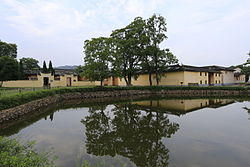Ruijin: Difference between revisions
No edit summary Tags: Mobile edit Mobile web edit |
No edit summary Tags: Mobile edit Mobile web edit |
||
| Line 30: | Line 30: | ||
It is most famous as one of the earliest centers of Chinese communist activity. After being forced out of [[Jinggang Mountains]] in the late 1920s by the [[Kuomintang]], the Communists fled here, taking advantage of Ruijin's relative isolation in the rugged mountains along Jiangxi's border with Fujian. In 1931, under [[Mao Zedong]]'s leadership, the [[Chinese Soviet Republic]] was established here, with Ruijin serving as its de facto capital. By 1934, they had again been surrounded by [[Chiang Kai-shek]]'s forces. It is from here that the famed "[[Long March]]" began.{{citation needed|date=July 2014}} |
It is most famous as one of the earliest centers of Chinese communist activity. After being forced out of [[Jinggang Mountains]] in the late 1920s by the [[Kuomintang]], the Communists fled here, taking advantage of Ruijin's relative isolation in the rugged mountains along Jiangxi's border with Fujian. In 1931, under [[Mao Zedong]]'s leadership, the [[Chinese Soviet Republic]] was established here, with Ruijin serving as its de facto capital. By 1934, they had again been surrounded by [[Chiang Kai-shek]]'s forces. It is from here that the famed "[[Long March]]" began.{{citation needed|date=July 2014}} |
||
When the Communists returned here in 1949, the county was also known for the [[Ruijin Massacre]] during the [[Cultural Revolution]]. |
|||
Ruijin is a popular destination for [[red tourism]] and [[ecotourism]]. It is a pilgrimage for [[Maoists]] from China and around the globe. |
Ruijin is a popular destination for [[red tourism]] and [[ecotourism]]. It is a pilgrimage for [[Maoists]] from China and around the globe. |
||
Revision as of 21:20, 15 December 2022
This article needs additional citations for verification. (January 2017) |
You can help expand this article with text translated from the corresponding article in Chinese. (May 2022) Click [show] for important translation instructions.
|
Ruijin
Juicheng, Juiking | |
|---|---|
 Ruijin | |
 Location in Jiangxi | |
| Coordinates: 25°53′10″N 116°01′37″E / 25.886°N 116.027°E | |
| Country | People's Republic of China |
| Province | Jiangxi |
| Prefecture-level city | Ganzhou |
| Postal Code | 342500 |
| Ruijin | |||||||||
|---|---|---|---|---|---|---|---|---|---|
| Chinese | |||||||||
| Postal | Juicheng | ||||||||
| |||||||||
Ruijin (Chinese:
It is most famous as one of the earliest centers of Chinese communist activity. After being forced out of Jinggang Mountains in the late 1920s by the Kuomintang, the Communists fled here, taking advantage of Ruijin's relative isolation in the rugged mountains along Jiangxi's border with Fujian. In 1931, under Mao Zedong's leadership, the Chinese Soviet Republic was established here, with Ruijin serving as its de facto capital. By 1934, they had again been surrounded by Chiang Kai-shek's forces. It is from here that the famed "Long March" began.[citation needed]
When the Communists returned here in 1949, the county was also known for the Ruijin Massacre during the Cultural Revolution.
Ruijin is a popular destination for red tourism and ecotourism. It is a pilgrimage for Maoists from China and around the globe.
Administrative divisions
Ruijin City has 7 towns and 10 townships.[1]
- 7 Towns
|
|
- 10 Townships
|
|
Climate
| Climate data for Ruijin (1981−2010) | |||||||||||||
|---|---|---|---|---|---|---|---|---|---|---|---|---|---|
| Month | Jan | Feb | Mar | Apr | May | Jun | Jul | Aug | Sep | Oct | Nov | Dec | Year |
| Record high °C (°F) | 27.9 (82.2) |
31.2 (88.2) |
31.7 (89.1) |
34.1 (93.4) |
35.8 (96.4) |
37.5 (99.5) |
40.4 (104.7) |
39.7 (103.5) |
37.4 (99.3) |
36.4 (97.5) |
33.5 (92.3) |
27.9 (82.2) |
40.4 (104.7) |
| Mean daily maximum °C (°F) | 13.4 (56.1) |
15.1 (59.2) |
18.6 (65.5) |
24.5 (76.1) |
28.4 (83.1) |
31.1 (88.0) |
34.2 (93.6) |
33.5 (92.3) |
30.4 (86.7) |
26.5 (79.7) |
21.2 (70.2) |
16.0 (60.8) |
24.4 (75.9) |
| Daily mean °C (°F) | 8.3 (46.9) |
10.5 (50.9) |
14.0 (57.2) |
19.8 (67.6) |
23.6 (74.5) |
26.4 (79.5) |
28.8 (83.8) |
28.1 (82.6) |
25.3 (77.5) |
20.7 (69.3) |
15.2 (59.4) |
9.7 (49.5) |
19.2 (66.6) |
| Mean daily minimum °C (°F) | 5.0 (41.0) |
7.3 (45.1) |
10.8 (51.4) |
16.3 (61.3) |
20.0 (68.0) |
23.0 (73.4) |
24.5 (76.1) |
24.3 (75.7) |
21.5 (70.7) |
16.5 (61.7) |
10.9 (51.6) |
5.5 (41.9) |
15.5 (59.8) |
| Record low °C (°F) | −5.2 (22.6) |
−2.5 (27.5) |
−2.1 (28.2) |
4.8 (40.6) |
11.4 (52.5) |
15.0 (59.0) |
19.4 (66.9) |
19.2 (66.6) |
12.5 (54.5) |
4.2 (39.6) |
−1.0 (30.2) |
−6.5 (20.3) |
−6.5 (20.3) |
| Average precipitation mm (inches) | 68.6 (2.70) |
121.1 (4.77) |
211.2 (8.31) |
216.3 (8.52) |
263.5 (10.37) |
262.8 (10.35) |
121.5 (4.78) |
146.5 (5.77) |
98.2 (3.87) |
50.4 (1.98) |
48.4 (1.91) |
43.8 (1.72) |
1,652.3 (65.05) |
| Average relative humidity (%) | 80 | 82 | 83 | 81 | 81 | 81 | 74 | 77 | 79 | 77 | 77 | 77 | 79 |
| Source: China Meteorological Data Service Center[2] | |||||||||||||
Transport
On 22 May 2016 the BBC reported that four cars fell into a sinkhole in Ruijin City.[3]
References
- ^ "
南京 市 -行政 区 划网 www.xzqh.org" (in Chinese). XZQH. Retrieved 2012-05-24. - ^
中国 地面 气候标准值月值(1981-2010) (in Simplified Chinese). China Meteorological Data Service Center. Retrieved 16 August 2022. - ^ "Sinkhole swallows four cars in China". BBC News.
